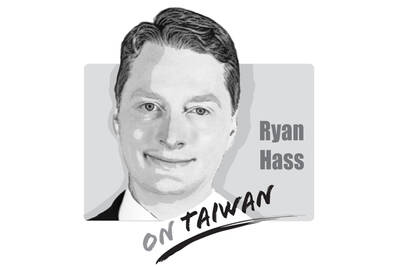On April 6 last year, the Ministry of Education sponsored a national conference in Taipei on Mandarin Romanization systems. Four competing systems were presented for deliberations at the conference: the Wade Giles (WG) System (
Of these, the Wade Giles system is the most traditional and, until very recently, the most widely used. But it has now lost its appeal largely because a total of 136 syllables require additional phonetic signs or diacritic marks, making it a fairly cumbersome system for printing and typing. As a consequence, a consensus emerged at the conference that the WG system should be rescinded from the list of potential systems for future deliberations.
The remaining three systems represent three different models of thinking. What underlines MPS-II is the credo that Taiwan should say no to whatever system China comes up with; adoption of the Hanyu Pinyin system, on the other hand, represents a contrary belief that there is little rational basis for going against a system that is already enjoying international currency. Finally, Taiwan Tongyong Pinyin was developed to achieve an optimal balance between internalization and national autonomy.
On June 21, the Ministry of Education, having decided to dump the MPS-II, proposed a still-newer system -- Guoyu Pinyin (
Six county commissioners and a dozen or so legislators from both sides of the aisle soon endorsed a proposal for the Executive Yuan to strive for a Romanization system which embodies the idea of internalization and national autonomy.
On July 26, the government, in a surprise move, announced the use of China's Hanyu Pinyin System for the Romanization of street names throughout the island, a move seen by many as a blatant disregard of the fact that the system is currently used in Beijing and could therefore suggest to the world that Taiwan is part of PRC.
Thereupon, 14 county commissioners and a number of prominent educators and linguists openly voiced strong opposition to the policy change, including Paul Jen-Kuei Lee (
On Sept. 16, legislator Weng Chin-chu (
Since the concept of IMS is nearly equivalent to that which underlies Tongyong Pinyin, it behooved us to consider in some detail the differences between Guoyu Pinyin and Taiwan Tongyong Pinyin. Basically, they boil down to two issues: One has to do with the way the zero-initial is handled. In Tongyong Pinyin, one single value is applied to all of the syllables with the same zero-initial. Thus the morpheme "
A second difference between Guoyu Pinyin and Tongyong Pinyin pertains to the issue of dentals and palatals.In Guoyu Pinyin, "
It is important to note that Tongyong Pinyin has joined hands with inventors of the Natural Input Method (
To sum up briefly, we believe that any Mandarin Romanization system developed for Taiwan should ideally strive for a principled balance between internalization and national autonomy as suggested above and that the Taiwan system should, therefore, contain distinctive features that sets it apart from China's Hanyu Pinyin. It is our hope, however, that the two systems may learn to accommodate each other in a productive symbiosis.
Hwang Hsuan-fan is director of the Graduate Institute of Linguistics at National Taiwan University; Chiang Wen-yu is associate professor of the Graduate Institute of Linguistics at National Taiwan University; Lo Seo-gim is a professor in the department of Chinese at National Changhua University of Education; and Robert Liang-wei Cheng is a professor in the department of East Asian languages and literatures at University of Hawaii in Manoa.

There are moments in history when America has turned its back on its principles and withdrawn from past commitments in service of higher goals. For example, US-Soviet Cold War competition compelled America to make a range of deals with unsavory and undemocratic figures across Latin America and Africa in service of geostrategic aims. The United States overlooked mass atrocities against the Bengali population in modern-day Bangladesh in the early 1970s in service of its tilt toward Pakistan, a relationship the Nixon administration deemed critical to its larger aims in developing relations with China. Then, of course, America switched diplomatic recognition
The international women’s soccer match between Taiwan and New Zealand at the Kaohsiung Nanzih Football Stadium, scheduled for Tuesday last week, was canceled at the last minute amid safety concerns over poor field conditions raised by the visiting team. The Football Ferns, as New Zealand’s women’s soccer team are known, had arrived in Taiwan one week earlier to prepare and soon raised their concerns. Efforts were made to improve the field, but the replacement patches of grass could not grow fast enough. The Football Ferns canceled the closed-door training match and then days later, the main event against Team Taiwan. The safety
The National Immigration Agency on Tuesday said it had notified some naturalized citizens from China that they still had to renounce their People’s Republic of China (PRC) citizenship. They must provide proof that they have canceled their household registration in China within three months of the receipt of the notice. If they do not, the agency said it would cancel their household registration in Taiwan. Chinese are required to give up their PRC citizenship and household registration to become Republic of China (ROC) nationals, Mainland Affairs Council Minister Chiu Chui-cheng (邱垂正) said. He was referring to Article 9-1 of the Act
The Chinese government on March 29 sent shock waves through the Tibetan Buddhist community by announcing the untimely death of one of its most revered spiritual figures, Hungkar Dorje Rinpoche. His sudden passing in Vietnam raised widespread suspicion and concern among his followers, who demanded an investigation. International human rights organization Human Rights Watch joined their call and urged a thorough investigation into his death, highlighting the potential involvement of the Chinese government. At just 56 years old, Rinpoche was influential not only as a spiritual leader, but also for his steadfast efforts to preserve and promote Tibetan identity and cultural